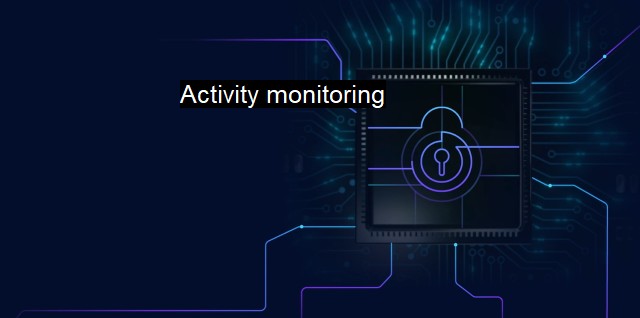What is Activity monitoring?
How Activity Monitoring Can Strengthen Cybersecurity Defenses: Real-time Insights for Detecting Threats and Ensuring Compliance
Activity monitoring is a critical component of an overarching strategy aimed at protecting digital assets from various types of threats and vulnerabilities. It is a comprehensive process of systematically observing, detecting, and recording the activities that occur within a network, a system, or a given set of digital assets like websites or databases to better understand the threats and mitigate risks.In an increasingly digitized world where data breaches and cyber-attacks are not uncommon, organizations can effectively safeguard their interests and those of their clients by using activity monitoring. Activity monitoring helps identify data entry errors, information leaks, and undesirable system behaviors, such as suspicious login attempts or unusual data transactions on a network. Through consistent supervision, organizations can affirm that their business operations comply with applicable data privacy laws.
Activity monitoring intersects with cybersecurity in many ways. It involves the use of various software applications and systems designed specifically for the purpose of intrusion detection and threat prevention. Constituting a part of a broader intrusion detection system (IDS), activity monitoring systems record and scrutinize all the activities taking place within an information system, raising alerts when potentially harmful actions are detected, thus enabling preventive measures to be implemented.
These systems function consistently, gathering data from a wide range of points across a network. For instance, they can track a user's interactions with a server, monitoring login parameters such as date, time, location, duration of connection, and even the data transferred. As such, they can determine irregular commands or functions that deviate from the norm, be those operating system requests or application level anomaly.
Activity monitoring interplays with antivirus software. Most modern antivirus applications include heuristic methodology in their design which effectively engages in a form of activity monitoring. In addition to scanning files for known virus signatures, these heuristics monitor for suspicious activities by applications, looking for patterns indicative of malware or virus-like behavior.
For instance, if a specific program or piece of software is repeatedly attempting to modify or write data in protected regions of hard-drive or memory, that activity would potentially trigger the antivirus system to inspect, quarantine or delete the problematic items. This way, an antivirus works proactively, not only neutralizing threats after the bewitching event has occurred but forestalling them entirely if possible.
Implementing activity monitoring models effective governance in system and network security management. It also bolsters the ability to maintain privacy policies and enables swift responses to compromises in the integrity of a network. Importantly, it lends businesses the agility to adapt and refurbish the security plans to the evolving nature of cyber threats.
It is crucial to articulate that activity monitoring isn't a panacea for all cybersecurity issues. Rather, the measure forms part of a holistic cybersecurity stance, a layered defense strategy meant to minimize gaps and augment security levels. From using secure, unique passwords and multi-factor authentication to ensuring software and operating systems are regularly updated to implementing firewalls and encryption, multiple cybersecurity instruments must work in concert to keep threats at bay. Activity monitoring is one cog in this vast machine.
Activity monitoring plays a frontline role in the context of cybersecurity. It can help in detecting malicious behaviors before they can do any harm, providing safety nets to both organizations and individuals in the digital realm. Protecting data and systems from cyber threats is a complex, ongoing process that necessitates vigilance and proactive involvement, and activity monitoring is integral in this endeavor. Ranging from confirming compliance with laws to effective prevention of data leaks and cyberattacks, the multifaceted merits of activity monitoring make it invaluable to the cybersecurity landscape.

Activity monitoring FAQs
What is activity monitoring?
Activity monitoring refers to the process of keeping track of the actions performed on a device or network. In the context of cybersecurity and antivirus, it involves monitoring users' activities to detect and prevent any malicious or unauthorized activity.Why is activity monitoring important in cybersecurity?
Activity monitoring is crucial in cybersecurity because it helps identify potential threats, detect suspicious behavior, and prevent attacks. It allows security teams to monitor user activity and identify any unusual or unauthorized actions, enabling them to act quickly to mitigate any potential harm.What types of activity are typically monitored in cybersecurity?
In cybersecurity, activity monitoring typically involves keeping track of a range of user activities, including login attempts, file transfers, website visits, and application usage. It may also involve monitoring network traffic and scanning for malware or virus outbreaks.How does activity monitoring work with antivirus software?
Antivirus software often includes activity monitoring as one of its features. It monitors the activity on a device or network, identifies any suspicious or malicious activity, and alerts the user or security team. Some antivirus software can also automatically block or quarantine any harmful activity detected.| | A | | | B | | | C | | | D | | | E | | | F | | | G | | | H | | | I | | | J | | | K | | | L | | | M | |
| | N | | | O | | | P | | | Q | | | R | | | S | | | T | | | U | | | V | | | W | | | X | | | Y | | | Z | |
| | 1 | | | 2 | | | 3 | | | 4 | | | 7 | | | 8 | | |||||||